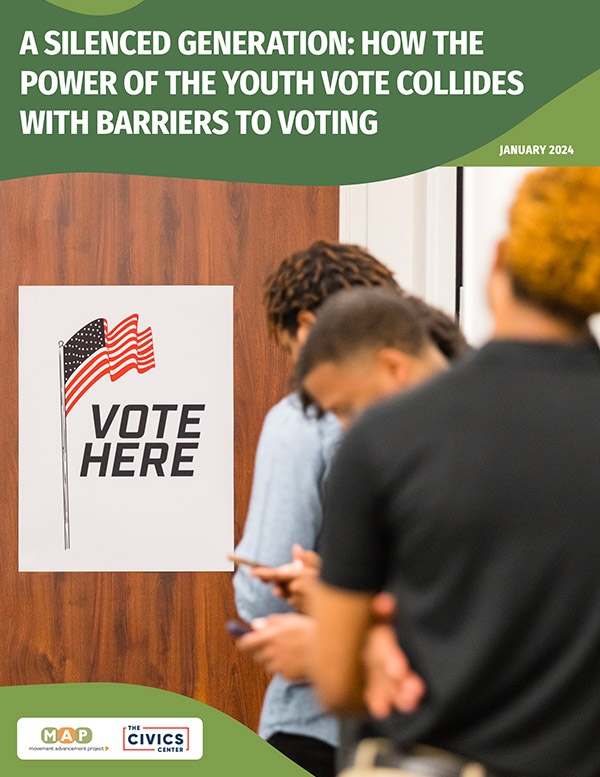"A Silenced Generation: How the Power of the Youth Vote Collides with Barriers to Voting"Download Report Table: Youth Democracy Scores, Ranked by State Download Table: Youth Democracy Scores, Ranked by Score Download Democracy Map: Voter PreregistrationView map Democracy Map: Automatic Voter Registration View map Democracy Map: Voter ID Requirements for In-Person VotingView map
Note: as of 1/19/24, this report includes an update regarding Washington state’s law allowing 17-year-olds to vote in primaries. This moves Washington from a Medium to a High Youth Democracy Score.
An estimated 53 million voters under 30 will be eligible to vote in 2024, including an estimated 8 million young people who have become newly eligible to vote since the 2022 midterm elections. As the 2024 election cycle ramps up, a new report by MAP, in partnership with the Civics Center, examines specific barriers that young voters face, what states can do to support young voters, and how each state’s election policies impact this important demographic.
Youth Democracy Scores MAP analyzed 11 key policies that particularly impact young voters to develop Youth Democracy Scores. This metric provides a look at the electoral landscape for young voters across the states, showing which states are providing robust youth voter environments and those that are not. Takeaways include:- Nearly one in 10 young voters live in a state with low Youth Democracy Scores.
- Almost one-third of young voters live in states that rank in the second lowest category of Youth Democracy Scores.
- The top five states in MAP’s Youth Democracy Scores are Illinois, Minnesota, Maryland, Colorado, and New Mexico. The states with the lowest five scores are Tennessee, Missouri, Alabama, Mississippi, Arkansas.
>> View the full tables of Youth Democracy Scores here: ranked alphabetically and by score.
Policy Recommendations Included in the report is a series of policy recommendations for how states can remove barriers and engage young voters. Lawmakers can take concrete steps to streamline voter registration and improve access to the ballot, including in the following areas: - Voter pre-registration: Twenty states and D.C. allow pre-registration at age 16, so long as the person will be 18 when they cast their vote. An additional four states allow pre-registration at age 17. Research shows that pre-registration results in higher voter turnout among young voters and is growing in popularity. From 2014 to 2020, the number of pre-registered young people more than doubled to nearly 1 million young voters.
- Election Day voter registration: Allowing voters to register the same day that they cast their vote is a fail-safe, especially for young voters and others who move more frequently and may face challenges with registration as a result. Only 22 states allow voters to register on the same day they vote.
- Voter ID and allowing student IDs: Most states ask voters to show some form of ID to vote. However, young people are less likely to have a driver's license, the most common form of ID, and may only have a student ID. Nine states explicitly do not allow a student ID to be used for voting, including several states with the most restrictive photo ID laws. Restrictive photo ID laws are particularly harmful to young people of color.
- Vote by mail: In 36 states, voters can request an absentee ballot without having to provide a reason. This makes voter participation easier for young voters, among other voters who may not be able to make it to a polling place. In states with the most restrictive mail voting policies, youth turnout is as much as 15 percentage points lower.
- Early voting availability: Young voters often work unpredictable schedules at hourly jobs where they may be forced to choose between wages and voting. Early voting increases the opportunities to vote, and youth voters are among the populations who benefit. In 2022, more than half of young voters cast their ballots before Election Day. While most states offer some form of in-person early voting, the length of availability varies widely.
Recommended citation format:
Movement Advancement Project. January 2024.
A Silenced Generation: How the Power of the Youth Vote Collides with Barriers to Voting. https://www.mapresearch.org/2024-youth-voting-report.


